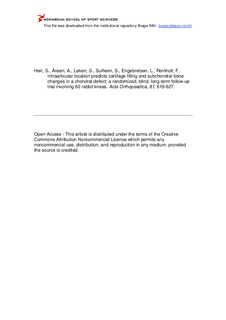| dc.contributor.author | Heir, Stig | |
| dc.contributor.author | Årøen, Asbjørn | |
| dc.contributor.author | Løken, Sverre | |
| dc.contributor.author | Sulheim, Steinar | |
| dc.contributor.author | Engebretsen, Lars | |
| dc.contributor.author | Reinholt, Finn P. | |
| dc.date.accessioned | 2011-01-12T12:54:27Z | |
| dc.date.available | 2011-01-12T12:54:27Z | |
| dc.date.issued | 2010-10 | |
| dc.identifier | Seksjon for idrettsmedisinske fag / Department of Sports Medicine | |
| dc.identifier.citation | Acta Orthopaedica. 2010, 81(5), 619-627 | en_US |
| dc.identifier.issn | 1745-3674 | |
| dc.identifier.uri | http://hdl.handle.net/11250/170661 | |
| dc.description | Open Access - This article is distributed under the terms of the Creative Commons Attribution Noncommercial License which permits any noncommercial use,
distribution, and reproduction in any medium, provided the source is credited. | en_US |
| dc.description.abstract | Background and purpose: The natural history of, and predictive factors for outcome of cartilage restoration in chondral defects are poorly understood. We investigated the natural history of cartilage filling subchondral bone changes, comparing defects at two locations in the rabbit knee. Animals and methods: In New Zealand rabbits aged 22 weeks, a 4-mm pure chondral defect (ICRS grade 3b) was created in the patella of one knee and in the medial femoral condyle of the other. A stereo microscope was used to optimize the preparation of the defects. The animals were killed 12, 24, and 36 weeks after surgery. Defect filling and the density of subchondral mineralized tissue was estimated using Analysis Pro software on micrographed histological sections. Results: The mean filling of the patellar defects was more than twice that of the medial femoral condylar defects at 24 and 36 weeks of follow-up. There was a statistically significant increase in filling from 24 to 36 weeks after surgery at both locations. The density of subchondral mineralized tissue beneath the defects subsided with time in the patellas, in contrast to the density in the medial femoral condyles, which remained unchanged. Interpretation: The intraarticular location is a predictive factor for spontaneous filling and subchondral bone changes of chondral defects corresponding to ICRS grade 3b. Disregarding location, the spontaneous filling increased with long-term follow-up. This should be considered when evaluating aspects of cartilage restoration. | en_US |
| dc.language.iso | eng | en_US |
| dc.publisher | Taylor&Francis | en_US |
| dc.subject | animals | |
| dc.subject | cartilage, articular | |
| dc.subject | disease models | |
| dc.subject | follow-up studies | |
| dc.subject | patella | |
| dc.subject | prognosis | |
| dc.subject | rabbits | |
| dc.subject | random allocation | |
| dc.subject | synovial fluid | |
| dc.subject | wound healing | |
| dc.title | Intraarticular location predicts cartilage filling and subchondral bone changes in a chondral defect | en_US |
| dc.type | Journal article | en_US |
| dc.type | Peer reviewed | en_US |
| dc.subject.nsi | VDP::Medical disciplines: 700::Clinical medical disciplines: 750 | en_US |
| dc.source.pagenumber | 619-627 | en_US |
